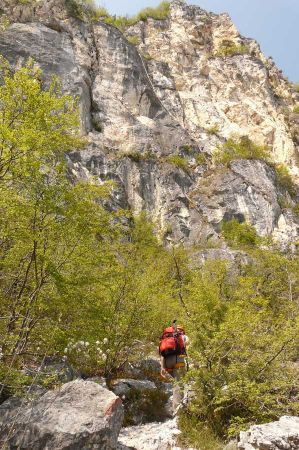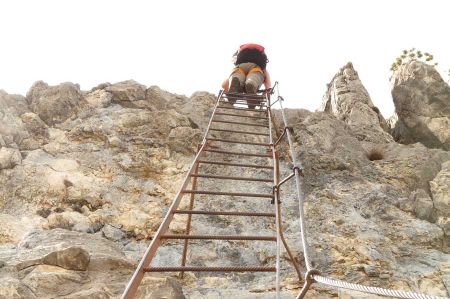Lake Garda Ferratas - Via Ferratas near Riva del Garda
- Written by Portal Editor
If a hike up into the mountains surrounding of Lake Garda is not enough for an adrenaline rush, you can also try the climbing system above the lake, provided that you have the appropriate equipment and can use it safely.
Because one of the best Lake Garda ferratas and one of the oldest climbing facilities in the region is located on the north shore of Lake Garda, directly above the much-visited tourist resort Riva del Garda. For the Via dell 'Amicizia you should at least have a certain level of fitness, because you have to climb almost 650 meters to the summit.
What is a ferrata and how is a via ferrata created?

A via ferrata is a climbing path on natural or artificial rock secured with iron ladders, iron pins, brackets (as steps) and (steel) ropes. In the past, rock passages on hiking trails were secured with steel cables. By the time, via ferratas developed from this, making increasingly difficult routes accessible for non-climbers. Today climbing via ferrata has developed into an alpine discipline of its own.
The iron brought into a via ferrata serves on one hand for movement (additional handles and steps) and on the other hand for self-protection with a so-called via ferrata set. In difficult via ferrata, self-belaying can also be supplemented by a rope team. Some climbers try to climb a route freely by using the iron inserted in the path just for safety and not for movement.
A current commercially available via ferrata set according to the UIAA standard generally consists of a rope brake and two pieces of rope, each with a via ferrata carabiner. In the event of a fall, a band specially sewn for this purpose - a band energy absorber - is torn or a piece of rope which is pulled through a rope brake plate. The approved systems can be constructed in different ways and are capable of cushioning a fall dynamically; There are a few variants on the market that are very similar in their fall-absorbing effect. There have recently also been systems that are moved up the steel cable by the climber, but which fix themselves against backward movement by means of a clamp mechanism.
Profession or obsession - climber builder
The via ferrata ropes are shortened to 30 meters and weigh around 50 kilos, depending on their strength. JUst after the material flight a fixed rope is stretched across the entire height of the rock. This fixed rope is used to enable the via ferrata builder to get up and down or to attach equipment.
“The weather often changes quickly here in the mountains,” explains Hans Prugger, “then it has to be very quick. At the "Anna" the cold snap came so quickly in October that I had to hurry to winterize everything while the rock froze below me. "
Work on the rock is carried out with a 50 kg generator, drill, step stirrups, clamps and anchor bolts as well as fixing compound. Drill, fill the holes with fixing compound, drive in the bolts and hang the climbing rope in the anchor bolt. These are the work steps to get via ferrata climbers safely to their destination. These measures took several weeks to complete on the newly built “Anna” via ferrata.
Exhausting inclines and relaxing path sections
The climb should not be underestimated due to its length and the altitude to be overcome. The ladders are very exposed, but not particularly difficult. Take enough fluids with you on hot days. The position of the stairs are completely in the sun in the morning.
Once at the top, via ferrata climbers have a breathtaking view of the deep blue Lake Garda, the town of Riva and the Sacratal valley to the north. Another highlight of this beautifully situated via ferrata are the two steep ladder passages. To really enjoy this Ferrata, you should choose a day with not too hot weather.
Please also read:
Meteora - climbing in unusual rock geology
The ruins of Tokmar Kalesi near Silifke
